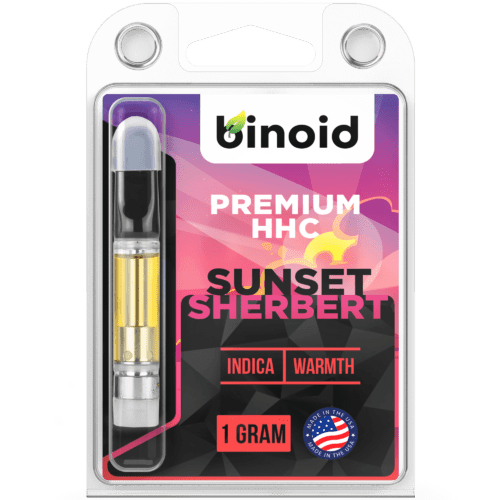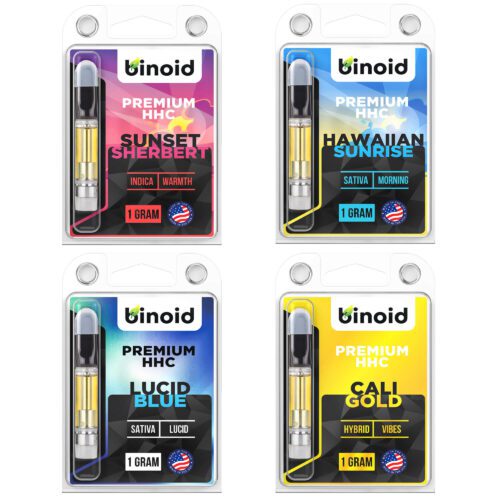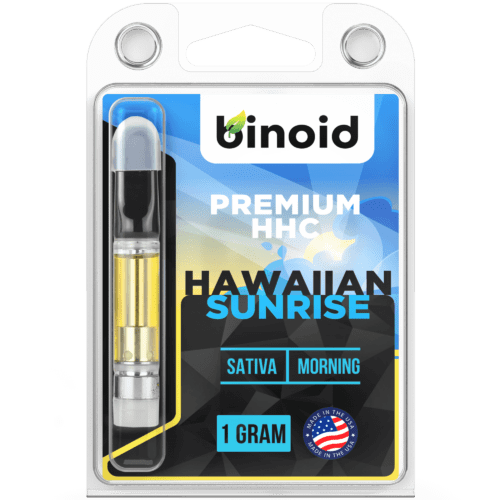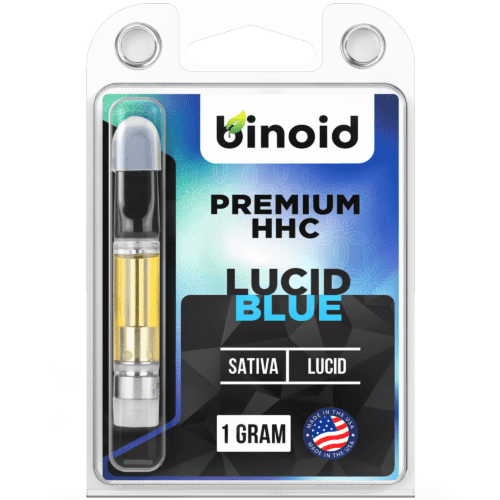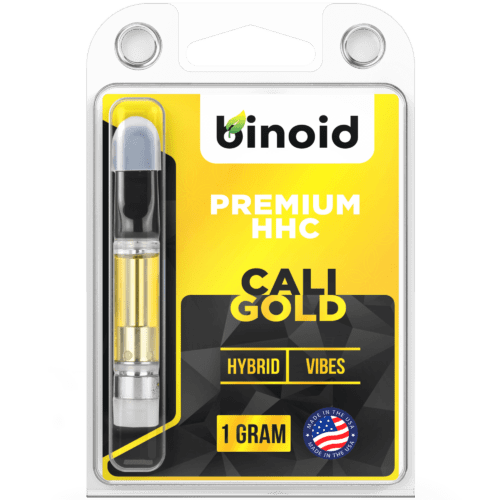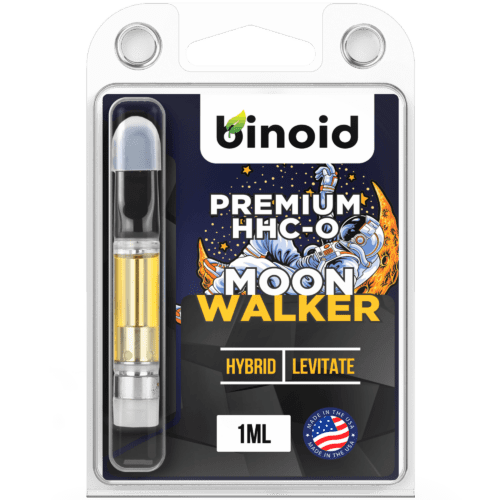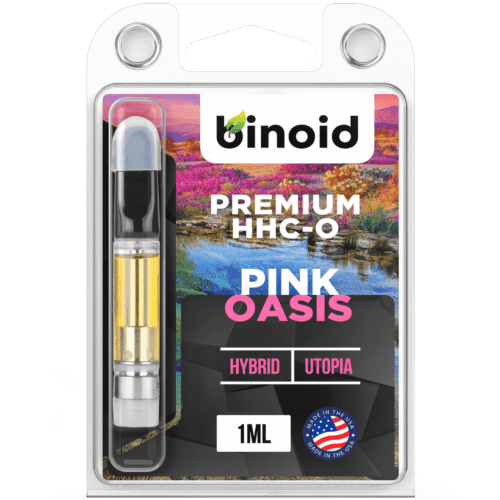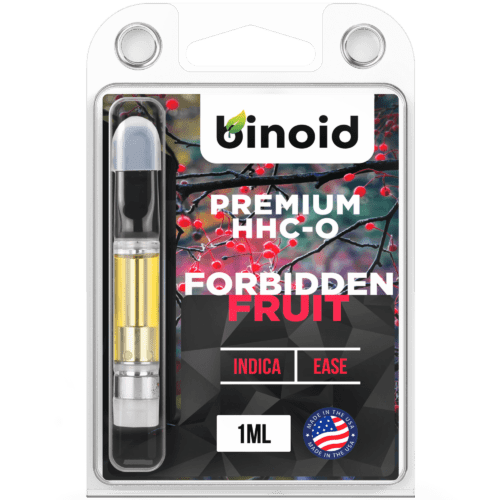The world of hemp-derived cannabinoids has expanded into a vast and intricate landscape, offering a spectrum of experiences that cater to nearly every preference and curiosity. Gone are the days of a monolithic understanding of cannabis; we now navigate a universe of nuanced compounds, each with its own distinct character and potential. This evolution has brought forth an exciting array of products, but none have captured the modern consumer’s imagination quite like vape cartridges.
These sleek, convenient devices have become the vessel for exploring this new frontier, delivering carefully crafted cannabinoid experiences with precision and ease. At the forefront of this movement is a fascinating intra-family rivalry, a compelling cannabinoid vape cartridges matchup that pits a popular parent compound against its chemically enhanced offspring: HHC vape cartridges vs. HHC-O vape cartridges.
To Buy Cannabinoid Vape Cartridges Click Here
Recommended products
What are Cannabinoids?
To truly appreciate the nuances of the HHC and HHC-O matchup, one must first understand the fundamental building blocks of their composition: cannabinoids. In the broadest sense, cannabinoids are a class of diverse chemical compounds that act on cannabinoid receptors in cells, which are part of the endocannabinoid system. These compounds are the primary drivers behind the effects associated with the cannabis plant, but their origins are not limited to botanical sources alone.
The scientific community categorizes them into three main groups: phytocannabinoids, which are produced by plants (most famously, the Cannabis sativa plant); endocannabinoids, which are produced naturally within the bodies of humans and other animals; and synthetic cannabinoids, which are created artificially in a laboratory setting. Cannabinoid derivatives like HHC and HHC-O have molecular structures that allow them to interface with our bodies’ internal systems, orchestrating a complex symphony of physiological responses that can influence everything from mood to perception.
The discovery and understanding of this intricate relationship are rooted in the endocannabinoid system (ECS), a crucial and sophisticated cell-signaling network that plays a vital role in regulating a vast array of functions to maintain a state of internal balance, or homeostasis. The ECS is composed of three core components: endocannabinoids (like anandamide and 2-arachidonoylglycerol, or 2-AG), which are the body’s own cannabinoid molecules; receptors that these compounds bind to (primarily CB1 receptors, found mostly in the central nervous system, and CB2 receptors, located in the peripheral nervous system and immune cells); and enzymes that break down the endocannabinoids once they have served their purpose.
Phytocannabinoids and their derivatives are able to produce their effects because they can mimic or influence our natural endocannabinoids, binding to these same receptors. The specific way a cannabinoid binds to these receptors—its shape, the strength of the bond (binding affinity), and whether it activates or blocks the receptor—determines its unique profile of effects.
Within the vast family of over one hundred identified phytocannabinoids, there is a clear distinction between major and minor compounds. Major cannabinoids, like cannabidiol (CBD) and Delta 9 THC, are the most abundant and well-known, having been the subject of extensive research and public discussion for decades. They are present in significant quantities in the raw plant material, making their extraction relatively straightforward and economically viable. In stark contrast, minor cannabinoids exist in much smaller, often trace, amounts, sometimes less than 1% of the plant’s total cannabinoid profile.
Most of the novel psychoactive compounds on the market are derived from these minor cannabinoids or are created by modifying major ones. Their natural scarcity makes direct extraction economically unfeasible, necessitating their creation through sophisticated laboratory processes, where a more plentiful cannabinoid like CBD is chemically transformed into these rarer isomers or serves as a base for further modification into compounds like HHC and HHC-O.
This entire framework of cannabinoid availability is governed by the 2018 Farm Bill, a pivotal piece of federal legislation. This bill legalized industrial hemp and its derivatives nationwide, on the condition that they contain no more than 0.3% Delta 9 THC by dry weight. While the law’s focus was on restricting Delta 9 THC, it inadvertently created a federally legal pathway for the widespread commercialization of all other cannabinoids that could be derived from compliant hemp, including semi-synthetic derivatives like the HHC family. This legal opening, combined with remarkable advancements in chemical synthesis and purification technologies, has fueled an explosion in product diversity. As a direct result, consumers now have an unprecedented ability to choose from a vast menu of cannabinoids to curate highly specific and targeted personal experiences.
Recommended products
What are Cannabinoid-Infused Vape Cartridges and How are They Typically Created?
Cannabinoid-infused vape cartridges, often simply called “vape carts,” are small, pre-filled containers that hold a liquid formulation of purified cannabinoid distillate and, typically, aromatic terpenes. These self-contained units are meticulously engineered to attach to a compatible battery, commonly known as a vape pen or 510-thread battery, which provides the necessary electrical power to heat the liquid and instantaneously transform it into an inhalable vapor. The primary function of a vape cartridge is to offer a convenient, discreet, and highly efficient method for consuming cannabinoids.
Unlike other consumption methods that require more preparation or have a significantly delayed onset, such as edibles, vaping allows for the rapid delivery of the active compounds directly into the bloodstream through the vast surface area of the lungs. This results in effects that can be felt almost immediately, often within a matter of minutes, providing users with unparalleled control over their experience as they can take small draws and precisely gauge the effects before deciding to continue.
The marketplace for cannabinoid vape cartridges is incredibly diverse, with products available in a multitude of shapes, sizes, and materials designed to suit various consumer preferences and accommodate ongoing technological advancements. The most ubiquitous size is the 1-gram (or 1mL) cartridge, which offers a substantial amount of oil that serves as a happy medium for both regular and occasional users. However, smaller half-gram options remain popular for those wishing to sample a new strain, while larger 2-gram, 3-gram, and even 5-gram disposable vape pens have emerged for users seeking maximum convenience and longevity.
In terms of shape, the classic cylindrical design with a 510-thread connection remains the undisputed industry standard due to its near-universal compatibility with the vast majority of batteries. Yet, some brands have pioneered proprietary pod-style systems that often feature a sleeker, more modern aesthetic and a magnetic connection, although they require a specific, brand-locked device to function. The materials used in cartridge construction are also a key differentiator, profoundly impacting performance, safety, and the purity of the user experience, with a clear hierarchy from basic plastics to premium glass and ceramic constructions.
While external designs may vary, the core components of a standard vape cartridge are universal and work in precise concert to deliver a smooth, flavorful, and consistent experience. Each part plays a critical, non-negotiable role in the device’s function, from the point of contact with the user to the electrical connection with the power source. A detailed breakdown reveals the intricate design that ensures safety and proper function:
Mouthpiece: This is the uppermost part of the cartridge through which the user inhales the vapor. Mouthpieces are crafted from a variety of materials, including common options like plastic, more premium choices like heat-resistant ceramic, and stylish alternatives like metal or wood. The shape can also differ—flat, rounded, or ergonomically contoured (“duckbill”)—to enhance comfort. The material choice is not merely aesthetic; ceramic mouthpieces, for instance, are excellent at dissipating heat, ensuring a cooler and more comfortable draw.
Tank/Reservoir (Chamber): The tank is the main body of the cartridge that holds the precious cannabinoid-infused oil. It must be transparent to allow the user to monitor the remaining liquid. While some budget cartridges may use polycarbonate plastic, high-quality tanks are almost exclusively made from borosilicate glass. This type of glass is highly durable and, most importantly, non-reactive, ensuring that there is no chemical leaching into the oil, which could alter the flavor and compromise the purity of the terpenes and cannabinoids.
Atomizer/Heating Element: The atomizer is the functional heart of the cartridge, responsible for heating the oil to its precise vaporization point (typically between 300-400°F). It consists of a heating coil wrapped around or embedded within a wicking material that draws in the oil. In modern, high-end cartridges, the atomizer core is made of a porous ceramic. This technology, often referred to by brand names like CCELL, provides exceptionally even heat distribution and a larger surface area, which prevents direct contact between the hot coil and the oil. This indirect heating is crucial for preventing burning, which would create a harsh taste and potentially harmful byproducts, and for preserving the delicate and complex flavor profile of the terpenes.
Base/Connector: The base is the bottom part of the cartridge that houses the atomizer and features the threading used to connect the device to a battery. The most common type is the 510-thread (referring to the 10 threads at 0.5 mm per thread), which has become the universal standard, ensuring interoperability between most cartridges and batteries on the market. The base also contains the airflow intakes—small holes that allow air to enter and mix with the vapor—and the electrical connection point that draws power from the battery to activate the heating element when the user inhales or presses a button.
The production of a cannabinoid-infused vape cartridge is a meticulous, multi-stage process that merges precision manufacturing with sophisticated chemical science to ensure a safe, effective, and enjoyable final product. This complex journey can be broken down into three distinct parts: the fabrication of the physical hardware, the formulation of the specialized oil, and the final assembly and rigorous quality control.
Part 1: How the Cartridge Itself is Made and Constructed
The manufacturing of the empty cartridge begins with the high-precision fabrication of its individual components in specialized facilities. The borosilicate glass for the tank is molded and cut to exact specifications. The ceramic for the atomizer core is created from refined mineral powders, which are then fired at extremely high temperatures and shaped, after which the metallic heating coil is carefully integrated. The mouthpiece and base are also manufactured, often through injection molding for plastics or CNC (Computer Numerical Control) machining for metals. These separate parts are then assembled in a sterile, dust-free clean-room environment (often adhering to ISO standards) to prevent any contamination. Throughout this process, stringent quality control is paramount, with manufacturers conducting tests for air-tightness to prevent leaks, ensuring proper airflow resistance for a good draw, and verifying that the electrical connections are sound and the 510-threading is perfectly machined.
Part 2: How the Cannabinoid-Infused Vape Oil is Made
This highly scientific stage starts with legally compliant, high-quality hemp biomass. The cannabinoids are first extracted from the plant material using various methods. For stable distillates, supercritical CO2 or ethanol extraction is common. For more volatile, full-spectrum extracts rich in acidic cannabinoids, cold extraction methods using solvents like butane or propane are often used to create “live resin.” After extraction, the oil is refined. For minor cannabinoids, this may involve complex isomerization to convert a precursor like CBD into the target molecule. For major cannabinoids, it may involve distillation to achieve high purity. Finally, this purified oil is formulated, often by reintroducing carefully selected terpene profiles to create the desired flavor, aroma, and strain-specific effects.
Part 3: Bringing It All Together
In the final stage, the precisely formulated cannabinoid and terpene mixture is gently heated to reduce its viscosity and is then carefully injected into the empty, assembled cartridges. This is typically done using automated filling machines in a sterile environment to ensure dosage consistency and prevent contamination. Once filled, the cartridges are securely capped or sealed to create an airtight container that prevents any leakage. The last and arguably most critical step is comprehensive third-party lab testing. A statistically significant sample from each batch is sent to an independent, ISO-accredited laboratory. There, it is tested for potency (to confirm cannabinoid percentages), purity (to ensure it is free from residual solvents, heavy metals, pesticides, and microbial contaminants), and legal compliance (to verify the Delta 9 THC level is at or below the 0.3% threshold). Only after passing these rigorous tests is the batch approved for packaging and release to the market.
Recommended products
Breaking Down Today’s Cannabinoid Vape Cartridges Matchup: HHC Vape Cartridges vs. HHC-O Vape Cartridges
With a comprehensive and expert-level understanding of cannabinoids and the intricate construction of vape cartridges now established, we can turn our full attention to the main event. This matchup is not about declaring one compound empirically superior to the other, but rather about illuminating the distinct characteristics, nuanced effects, and ideal use cases that define each one. HHC and HHC-O are both marvels of modern cannabinoid science, offering profoundly different avenues of experience. This exploration is the key to empowering you to make an informed decision that aligns perfectly with your personal preferences and desired experience.
Contender #1: HHC Vape Cartridges
Making its entrance as a formidable and highly popular contender is HHC. HHC vape cartridges have carved out a significant space in the hemp-derived market, lauded by consumers for offering a unique and compelling alternative to traditional THC isomers. It is celebrated for its remarkable stability and for delivering an experience that many users find to be a perfect middle ground—potent and euphoric, yet often perceived as more relaxing and less prone to inducing feelings of unease than its THC cousins. This has made HHC a go-to choice for a wide range of users, from those seeking a reliable and enjoyable psychoactive experience without the legal complexities of Delta 9 THC, to seasoned enthusiasts who appreciate its smooth character and well-rounded effects.
Hexahydrocannabinol (HHC) is a semi-synthetic hydrogenated cannabinoid. This means it is not typically found in meaningful quantities in the cannabis plant but is instead created in a laboratory through a process called hydrogenation. This process, first discovered by the American chemist Roger Adams in the 1940s, involves taking a THC molecule (like Delta 8 or Delta 9 THC) and saturating it with hydrogen atoms in the presence of a metal catalyst like palladium. This reaction breaks the double bonds in the THC molecule’s carbon ring, replacing them with hydrogen atoms.
The result is a new, more stable molecular structure. This stability is HHC’s defining feature, making it highly resistant to degradation from heat, light, and oxidation, which gives it a much longer shelf life than THC. The process also creates two different types of HHC molecules, known as epimers: 9R-HHC, which is psychoactive and binds effectively to cannabinoid receptors, and 9S-HHC, which is largely inactive. The ratio of these two epimers in a final HHC product is crucial, as it directly determines the overall potency of the experience.
Now, the market for HHC vape cartridges has matured rapidly, offering an impressive array of products designed to highlight its unique and enjoyable properties. Brands have developed a comprehensive range of options that allow consumers to experience HHC in various forms, from pure, unadulterated distillates to complex, synergistic blends, all aimed at delivering its signature effects in a smooth, flavorful, and enjoyable format. The customization options below are extensive, enabling users to select products that perfectly match their lifestyle, preferences, and desired mental state:
Shapes & Sizes: HHC cartridges predominantly conform to established industry standards, most frequently appearing in 1-gram cylindrical formats equipped with the universal 510-threading. However, as various brands strive to differentiate their offerings and cater to specific consumer habits, users can also discover smaller half-gram options ideal for lighter use or sampling, larger 2-gram or even 3-gram disposable vapes for ultimate convenience and prolonged enjoyment, and sleek, proprietary pod systems that are designed to pair with brand-specific batteries, often boasting unique features or form factors.
How They’re Constructed: Premium HHC cartridges are invariably constructed using high-quality, inert materials to guarantee optimal performance, user safety, and the preservation of flavor. This typically includes a non-reactive borosilicate glass tank to contain the viscous oil and an advanced ceramic core atomizer (such as CCELL technology) that ensures consistent, low-temperature heating. This superior construction is absolutely critical for preventing the oil from burning, which would create a harsh, acrid taste, and it ensures that the full spectrum of delicate terpenes is vaporized efficiently for a smooth, pure, and flavorful draw from the first puff to the last.
Potential Use of Live Resin or Live Rosin: To elevate the user experience far beyond that of a standard distillate cartridge, many top-tier HHC products incorporate live resin or live rosin. Live resin is a highly sought-after cannabis concentrate produced from fresh, flash-frozen cannabis plants, a method that preserves a much wider and more volatile array of terpenes and other aromatic compounds compared to traditional techniques that use dried and cured plant material. The addition of these full-spectrum extracts to HHC distillate results in a profoundly more robust, authentic flavor profile and a more nuanced, well-rounded experience often attributed to the “entourage effect”.
Strain-Infused: The perceived effects of an HHC cartridge are heavily shaped by its specific terpene profile, which is carefully formulated to replicate the characteristics of well-known cannabis strains. Sativa-dominant strains are infused with terpenes like limonene and pinene, which are known for their uplifting, citrusy, and piney aromas, making them an excellent choice for daytime activities. Indica-dominant strains typically feature terpenes such as myrcene and linalool, which are associated with relaxation and calming, earthy aromas, perfect for evening use or unwinding. Hybrid strains are formulated to offer a balanced blend of both, providing a versatile experience that can be suitable for nearly any time of day.
Sometimes Combined with Other Cannabinoids: The true artistry in the modern cannabinoid market lies in the creation of unique, synergistic blends designed for specific effects. HHC‘s stable and well-rounded profile makes it an excellent base for a wide range of combinations:
Mild Potency: For a gentler, more nuanced experience, HHC can be blended with cannabinoids like Delta 10 or THCV. This can create a Sativa-leaning effect that combines the uplifting energy of Delta 10 with the smooth euphoria of HHC, perfect for social situations or creative tasks.
Moderate Potency: HHC is often blended with Delta 8 THC to produce a deeply relaxing and balanced experience, combining the best of both worlds. It can also be paired with THCA to create a potent, classic high with the added stability and unique character of HHC.
Strong Potency: For the most experienced users seeking the maximum possible effect, HHC is expertly blended with other highly potent minor cannabinoids like THC-P, THC-H, or even its own derivatives like HHC-O and HHC-P. These blends are designed to deliver an overwhelmingly powerful and long-lasting experience that pushes the boundaries of intensity.
The overall effects of an HHC vape cartridge are characterized by a potent yet smooth euphoria that is often compared to a slightly milder version of Delta 9 THC. Its functional aspects are defined by this balance; it provides a significant psychoactive experience that is both cerebral and physically relaxing, but many users report that it is less likely to induce the feelings of unease or paranoia that can sometimes accompany high doses of THC. This baseline experience becomes much more textured when combined with other formulation factors.
A strain-infused Sativa disposable can make the effects feel more energetic and creative, while an Indica blend can produce a profoundly tranquilizing sensation perfect for deep relaxation. The inclusion of live resin elevates this further by providing a richer, more authentic taste and a more full-bodied, entourage-driven feeling. When blended with other cannabinoids, HHC can serve as a stable foundation for a wide array of targeted effects, from the gently uplifting to the overwhelmingly potent.
Recommended products
Pros & Cons
Like any product, HHC vape cartridges come with their own distinct set of advantages and potential drawbacks. A thorough understanding of these can help you determine if they are the right fit for your personal needs, tolerance, and expectations.
Pros:
Enhanced Stability: The hydrogenation process used to create HHC makes it a structurally more stable molecule than THC. It is highly resistant to degradation from heat, UV light, and oxidation. This means HHC vape cartridges have a significantly longer shelf life and are less likely to lose their potency over time, offering a more reliable and consistent product for the consumer.
Effects Similar to Delta 9 THC: For many users, the primary appeal of HHC is that its effects are remarkably similar to those of traditional Delta 9 THC. It provides a potent and enjoyable experience that includes euphoria, altered perception, and physical relaxation. This makes it an excellent legal alternative for those in areas where Delta 9 THC is not accessible.
Often More Relaxing High: A significant body of anecdotal evidence suggests that HHC provides a high that is more relaxing and less likely to induce feelings of unease or paranoia compared to Delta 9 THC. This makes it a preferred choice for individuals who are sensitive to the anxiety-provoking side effects of traditional THC, offering a smoother and more reliably pleasant journey.
Federally Legal (Hemp-Derived): Because HHC is typically created from hemp-derived CBD or other cannabinoids, it falls under the same legal framework as Delta 8 established by the 2018 Farm Bill. This makes it federally legal, allowing it to be purchased online and shipped to many states. This accessibility is a major advantage over state-regulated cannabis products.
Versatility in Blends: HHC’s well-rounded and stable nature makes it a fantastic base cannabinoid for creating complex blends. Its effects are potent but not typically overwhelming, providing a solid foundation upon which formulators can layer other minor and major cannabinoids. It can be used to create everything from mild, functional blends to extremely potent concoctions.
Great for Moderate Potency Users: HHC strikes a perfect balance of potency that appeals to a broad range of consumers. It is noticeably stronger than Delta 8, providing a more substantial experience, but is often considered slightly less intense than Delta 9 THC. This positions it perfectly for users who have graduated from milder cannabinoids and are seeking a more robust effect without venturing into overwhelming territory.
Novel Alternative to THC: For seasoned enthusiasts who are very familiar with the effects of various THC isomers, HHC offers a novel and unique experience. While similar, its character is distinct, providing a different “flavor” of high that can be a welcome change of pace. Exploring these nuances is a major part of the appeal for cannabinoid connoisseurs.
May Not Show on Standard THC Drug Tests: This is a highly debated and important point that comes with a major caveat. Because HHC is not a THC molecule, it is not metabolized into THC-COOH, the primary metabolite that standard drug tests look for. Some anecdotal evidence suggests users have passed drug tests after consuming HHC. However, this is not guaranteed, and some advanced drug tests may be able to detect it. No one subject to drug testing should rely on this as a certainty.
Cons:
Less Research than THC: While HHC has been known to science for a long time, it has only recently become a popular consumer product. As such, there is significantly less clinical research on its long-term effects, safety profile, and metabolic pathways compared to more common cannabinoids like Delta 9 THC and CBD. This lack of extensive data is a valid consideration for many users.
Potency Can Vary: The psychoactive potency of HHC is almost entirely dependent on the ratio of the active 9R-HHC epimer to the inactive 9S-HHC epimer in the distillate. This ratio can vary between batches and manufacturers. A product with a high 9R ratio will be very potent, while one with a low 9R ratio may feel weak. This potential for inconsistency can be a drawback.
Legal Ambiguity at the State Level: Despite being federally legal, the status of HHC is highly contentious at the state level. Many states have passed laws that ban or restrict all THC isomers and analogues, and HHC often falls under these broad definitions. This creates a confusing and constantly changing legal landscape that requires consumers to be diligent in checking their local laws.
Production Methods Require Scrutiny: Since HHC is created via a chemical process involving a catalyst, the expertise and ethics of the manufacturer are paramount. Improper production or purification can result in a final product that contains residual solvents or heavy metals from the catalyst. It is absolutely essential to only purchase HHC from reputable brands that provide comprehensive, full-panel lab tests for every batch.
Recommended products
Contender #2: HHC-O Vape Cartridges
HHC-O vape cartridges have carved out a formidable niche in the market, emerging from the cutting edge of cannabinoid chemistry to cater specifically to experienced users in search of a new echelon of potency and effect duration. These products are consistently discussed in terms of their amplified intensity, delivering an experience that is palpably more profound and immersive than what is offered by many of the naturally occurring cannabinoids available on the legal hemp market.
HHC-O is widely celebrated for its ability to deliver a powerful, all-encompassing wave of euphoria that is simultaneously cerebral and deeply relaxing on a physical level, forging a holistic and long-lasting effect that clearly distinguishes it from its peers. This powerful reputation has positioned HHC-O as a preferred choice for seasoned enthusiasts with established tolerances, those who are searching for a more significant and enveloping psychoactive journey ideal for deep creative endeavors, meditative practices, or simply achieving a state of ultimate, blissful tranquility.
At its scientific core, HHC-O (Hexahydrocannabinol-O-acetate), also known as HHC-O-Acetate, is a semi-synthetic cannabinoid derivative. It is not found naturally in the cannabis plant; instead, it is synthesized in a controlled laboratory environment through a specific two-step chemical process. The journey begins with its parent compound, HHC. In the second, defining step, acetylation, chemists add an acetyl group to the HHC molecule.
This crucial molecular modification transforms HHC-O into what is known as a “prodrug.” This means that the compound itself is largely inactive until it is metabolized by enzymes within the body, which then cleave off the acetyl group, releasing the highly active HHC molecule directly to the body’s cannabinoid receptors. This metabolic pathway is scientifically believed to dramatically increase the bioavailability and potency of the original HHC, resulting in a significantly more powerful and longer-lasting experience for the user.
Now, the sheer variety of HHC-O vape cartridges available on the market today stands as a powerful testament to the industry’s unceasing innovation, offering a meticulously customized experience for virtually every type of user. While the primary active ingredient is always the potent HHC-O, the final product can be modified in a multitude of ways, with each variation detailed below profoundly affecting the overall character, flavor profile, and functional performance of the vape:
Shapes & Sizes: HHC-O cartridges predominantly conform to established industry standards, most frequently appearing in 1-gram cylindrical formats equipped with the universal 510-threading. However, as various brands strive to differentiate their offerings and cater to specific consumer habits, users can also discover smaller half-gram options ideal for lighter use or sampling, larger 2-gram or even 3-gram disposable vapes for ultimate convenience and prolonged enjoyment, and sleek, proprietary pod systems that are designed to pair with brand-specific batteries, often boasting unique features or form factors.
How They’re Constructed: Premium HHC-O cartridges are invariably constructed using high-quality, inert materials to guarantee optimal performance, user safety, and the preservation of flavor. This typically includes a non-reactive borosilicate glass tank to contain the viscous oil and an advanced ceramic core atomizer (such as CCELL technology) that ensures consistent, low-temperature heating. This superior construction is absolutely critical for preventing the oil from burning, which would create a harsh, acrid taste, and it ensures that the full spectrum of delicate terpenes is vaporized efficiently for a smooth, pure, and flavorful draw from the first puff to the last.
Potential Use of Live Resin or Live Rosin: To elevate the user experience far beyond that of a standard distillate cartridge, many top-tier HHC-O products incorporate live resin or live rosin. Live resin is a highly sought-after cannabis concentrate produced from fresh, flash-frozen cannabis plants, a method that preserves a much wider and more volatile array of terpenes and other aromatic compounds compared to traditional techniques that use dried and cured plant material. The addition of these full-spectrum extracts to HHC-O distillate results in a profoundly more robust, authentic flavor profile and a more nuanced, well-rounded experience often attributed to the “entourage effect”.
Strain-Infused: The perceived effects of an HHC-O cartridge are heavily shaped by its specific terpene profile, which is carefully formulated to replicate the characteristics of well-known cannabis strains. Sativa-dominant strains are infused with terpenes like limonene and pinene, which are known for their uplifting, citrusy, and piney aromas, making them an excellent choice for daytime activities. Indica-dominant strains typically feature terpenes such as myrcene and linalool, which are associated with relaxation and calming, earthy aromas, perfect for evening use or unwinding. Hybrid strains are formulated to offer a balanced blend of both, providing a versatile experience that can be suitable for nearly any time of day.
Sometimes Combined with Other Cannabinoids: The true artistry in the modern cannabinoid market lies in the creation of unique, synergistic blends designed for specific effects. HHC-O‘s potent foundation can be masterfully combined with other cannabinoids to create highly targeted experiences:
Mild Potency: To craft a more manageable yet deeply layered experience, formulators might blend HHC-O with cannabinoids like Delta 10 for a combined effect of cerebral energy and potent euphoria, or with THCV and THCM to introduce unique stimulating nuances that complement the powerful HHC-O base without making it overly sedating.
Moderate Potency: For users who desire a significant but well-rounded euphoric lift, HHC-O is often combined with Delta 8 THC to add a layer of familiar calm and body relaxation. It can also be blended with THCA, which converts to potent Delta 9 THC upon heating, or Delta 11 and HXY-10 THC to create a complex, multi-faceted high with layers of different onsets and effects.
Strong Potency: For the most experienced users seeking the absolute maximum possible effect, HHC-O is expertly blended with other highly potent minor cannabinoids like THC-P, THC-H, or its more powerful sibling, HHC-P. These compounds are renowned for their exceptionally strong binding affinity to cannabinoid receptors and can dramatically amplify the overall potency, duration, and character of the experience, launching the user into an incredibly powerful and profound journey.
The overall effects of an HHC-O vape cartridge are defined by a potent, all-encompassing euphoria that features both a strong cerebral component and a deeply felt physical relaxation. Its functional aspects are geared towards experienced users, as its intensity can be quite significant, often leading to a profoundly altered state of perception and a powerful sense of bliss that can last for an extended period. This baseline experience becomes much more textured when combined with other formulation factors.
A strain-infused Sativa disposable can make the cerebral effects feel intensely creative and expansive, while an Indica blend can produce a profoundly tranquilizing sensation perfect for deep rest. The inclusion of live resin elevates this further by providing a richer, more authentic taste and a more full-bodied, entourage-driven feeling. When blended with other cannabinoids, HHC-O serves as a powerful engine, capable of driving blends to a much higher level of intensity and duration.
Recommended products
Pros & Cons
Like any product, especially those created through advanced chemical modification, HHC-O vape cartridges come with their own distinct set of advantages and potential drawbacks. A thorough understanding of these can help you determine if they are the right fit for your personal needs, tolerance, and expectations.
Pros:
Enhanced Potency: HHC-O is widely reported to be significantly more potent than its parent compound, HHC, often estimated to be around 1.5 times stronger. This increased strength is a direct result of the acetylation process, which is believed to improve the bioavailability of HHC after metabolism. For experienced users with a tolerance to HHC, this provides a satisfyingly robust step up in effect that offers a fresh and more powerful experience.
Long-Lasting Effects: A defining characteristic of HHC-O is the prolonged duration of its effects. Users often report that the experience lasts noticeably longer than with HHC or even Delta 9 THC. This extended duration offers great value, as it may require less frequent consumption to maintain a desired state. It makes HHC-O particularly well-suited for activities where you want a sustained experience, such as a long movie, a creative project, or a full evening of relaxation.
Profound Euphoria: The quality of the experience delivered by HHC-O is frequently described as a deep and immersive euphoria. It combines a powerful cerebral lift with a warm, comforting full-body sensation, creating a comprehensive sense of bliss. This well-rounded effect is highly sought after by those looking for more than just a mild buzz, providing a truly transformative and enveloping journey that can enhance mood and perception in a significant way.
Smoother Inhalation Experience: A commonly noted anecdotal benefit of acetylated cannabinoids like HHC-O is a smoother vapor that is less harsh on the throat and lungs during inhalation. While the exact reason for this is not fully understood, many users find it provides a more comfortable and pleasant vaping experience compared to some other distillates. This can be a significant advantage for individuals who are sensitive to the harshness that can sometimes accompany high-potency cannabinoid vapor.
Delayed Onset for Gradual Experience: Because HHC-O is a prodrug that requires metabolization to become active, there is often a noticeable delay in the onset of its effects, typically around 15-30 minutes after inhalation. While this requires patience, it can also be a benefit, as the effects tend to build more gradually rather than hitting all at once. This can lead to a more comfortable and less overwhelming transition into the peak of the experience for some users.
Excellent Base for Potent Blends: Due to its inherent strength, HHC-O serves as an exceptional foundation for creating highly potent and targeted cannabinoid blends. Formulators can use its powerful effects as a canvas, layering on other cannabinoids like THC-P or HHC-P to create synergistic products with unmatched intensity. This versatility allows for the development of some of the most powerful legal hemp products available on the market today.
Increased Stability: HHC-O is built upon the highly stable HHC molecule, which is resistant to heat, light, and oxidation due to its hydrogenated structure. This inherent stability could potentially give HHC-O vape cartridges a longer and more reliable shelf life compared to their THC-based counterparts. This means the product is more likely to maintain its original potency for a greater length of time if stored properly.
Novelty and Exploration: For the seasoned cannabinoid enthusiast, the emergence of novel compounds like HHC-O offers an exciting opportunity for exploration. Trying a new cannabinoid with a unique effect profile and mechanism of action can be an enjoyable experience in itself, allowing users to expand their understanding of how different molecular structures interact with their endocannabinoid system. It represents the cutting edge of hemp science.
Cons:
Not Suitable for Beginners: The significant potency and delayed onset of HHC-O make it a poor choice for individuals new to psychoactive cannabinoids. A novice user could easily overconsume by taking multiple puffs before the initial dose has taken full effect, leading to an uncomfortably intense experience. Its strength requires a pre-existing understanding of one’s own tolerance and sensitivity, which beginners simply do not have.
Delayed Onset Can Be Deceptive: The same delayed onset that some users find pleasant can be a considerable drawback for others, particularly those accustomed to the immediate feedback of inhaled HHC or THC. This delay can make it very difficult to properly titrate, or control, one’s dose. A user might mistakenly conclude that the product is not working and consume more, only to be hit with the full, compounded effects of all doses simultaneously a short while later.
Lack of Scientific Research: As a relatively new semi-synthetic compound on the consumer market, HHC-O is not supported by a substantial body of long-term scientific and clinical research. While it is derived from HHC, the full effects of inhaling its acetylated form over extended periods are not well understood. This forces a reliance on anecdotal user reports rather than rigorous scientific data, which presents a significant unknown for consumers.
Complex Legal Gray Area: The legal status of HHC-O is even more ambiguous and precarious than that of HHC. Although it is derived from hemp, its semi-synthetic nature places it in a challenging legal position, potentially falling under the purview of the Federal Analogue Act. Furthermore, many states that have banned Delta 8 have also moved to prohibit all synthetically-derived cannabinoids, making HHC-O explicitly illegal in numerous jurisdictions.
Recommended products
Other Key Things You Should Know About When Choosing Either HHC Vape Cartridges or HHC-O Vape Cartridges
Choosing between HHC and HHC-O vape cartridges is a decision that extends far beyond simply picking between two different product names. It is a choice between two closely related but distinct experiences, demanding an honest assessment of your personal tolerance, desired outcome, and understanding of cannabinoid science. The current hemp-derived cannabinoid market, while innovative and exciting, operates in a space with minimal federal oversight, which places the burden of due diligence squarely on you, the consumer.
To navigate this complex landscape safely and effectively, it is absolutely essential to look beyond the flashy marketing claims and scrutinize the factors that truly define a product’s quality, safety, and suitability for your specific needs. The following points provide a comprehensive checklist of critical considerations that every consumer should be aware of before making any purchase.
Source of Hemp: The absolute foundation of any high-quality cannabinoid product is the hemp from which it is derived. The quality of this starting botanical material directly and profoundly impacts the purity and safety of the final distillate. It is imperative to choose products made from hemp grown in the United States, as domestic farmers are subject to federal and state regulations regarding cultivation practices under the Farm Bill. Look for brands that are completely transparent about their sourcing, preferably using hemp grown with organic and sustainable methods.
Third-Party Lab Testing (COAs): This is, without exaggeration, the single most important factor in verifying the safety, potency, and legitimacy of a vape cartridge. A Certificate of Analysis (COA) is a document from an accredited, independent third-party laboratory that details the precise composition of the product. Never purchase a cannabinoid product from a brand that does not make these reports easily accessible for every batch. A comprehensive “full panel” test should include potency analysis (confirming HHC and HHC-O levels and ≤0.3% Delta 9 THC), a purity panel for residual solvents, a heavy metals test, a comprehensive pesticide screening, and a test for microbial contaminants.
Extraction and Conversion Methods: For these advanced cannabinoids, the lab processes are critical. Both HHC and HHC-O are the result of sophisticated, multi-step chemical syntheses. These processes must be performed with extreme precision by qualified chemists in a professional laboratory. Improper reactions can leave behind unwanted byproducts or residual catalysts. Trustworthy brands will utilize advanced purification techniques like flash chromatography to ensure you receive only the pure, target cannabinoids.
Terpene Profiles: Terpenes do far more than provide taste; they shape the effects via the entourage effect, which can be especially important for modulating the potent experiences of HHC and HHC-O. The highest quality products will feature cannabis-derived terpenes (CDTs) or, even better, live resin infusions. These provide an authentic, nuanced flavor and a more well-rounded effect that can help to “steer” the powerful journey in a more pleasant direction.
Cartridge Hardware Quality: The oil is only half the equation; the hardware is equally critical. Low-quality cartridges can clog, leak, or use cheap coils that burn the oil, creating a harsh taste and potentially harmful byproducts. The best cartridges use inert materials like borosilicate glass tanks and advanced ceramic heating elements (e.g., CCELL technology). Furthermore, ensure the hardware itself has been tested for heavy metal leaching.
Your Personal Tolerance: This is a key distinction in this matchup. HHC is suitable for intermediate to experienced users looking for a potent but manageable high. HHC-O is a step up, best reserved for those who are already very familiar with HHC and are seeking a more intense, longer-lasting experience. A newcomer to potent cannabinoids should start with something milder before trying either of these.
Desired Experience: Clearly define your goal. Are you seeking a reliable, stable, and potent euphoric experience that is similar to THC but smoother? An HHC cartridge is the perfect tool. Are you a high-tolerance user looking for an amplified, enveloping, and uniquely profound journey with a delayed onset and very long duration? An HHC-O blend is the choice for that specific, and more advanced, job.
The Importance of the Battery (Vape Pen): Your experience is significantly impacted by the battery you use. A simple, buttonless battery will work, but a more advanced battery with variable voltage settings and a pre-heat function offers far more control. Lower voltage settings (e.g., 2.5V-2.8V) will better preserve the delicate terpenes in a live resin cart. A pre-heat function is invaluable for preventing clogs with these thick distillates.
Legal Landscape: The legal status of these compounds is extraordinarily complex. As semi-synthetic compounds, both HHC and HHC-O exist in a precarious legal gray area that may fall under the Federal Analogue Act. Critically, individual states can and do create their own regulations that are stricter than the federal Farm Bill, specifically banning any and all HHC compounds. It is your sole responsibility as a consumer to research and be aware of the most current laws in your specific state and local jurisdiction before making a purchase.
Brand Reputation and Transparency: In a largely unregulated industry, a brand’s reputation is your best indicator of quality. Look for companies with a long-standing, positive presence and a commitment to transparency. A trustworthy brand will have a professional website with clear information about their sourcing, manufacturing processes, and, most importantly, easily accessible lab test results for every product batch.
Understanding Blends: While HHC is often sold as a pure distillate, both are frequently found in blends. Read the lab report carefully to understand the exact cannabinoid ratios. A blend containing HHC-O will be noticeably stronger and longer-lasting than a pure HHC product. Understanding what each component contributes is crucial for predicting the experience.
Set and Setting: With cannabinoids of this magnitude, the concept of “set and setting” becomes crucial. “Set” refers to your mindset—be in a calm, positive, and prepared state of mind. “Setting” refers to your physical environment—be in a safe, comfortable, and familiar place where you can relax without responsibilities for a very long time. This is especially important when trying the delayed-onset HHC-O for the first time.
Recommended products
The Choice Between Now and Later
In the final analysis, the choice between HHC and HHC-O vape cartridges is not just about potency, but about the very mechanics of the experience. It is a decision between the immediate and the delayed, the foundational and the enhanced. HHC offers the reliable, stable, and potent satisfaction of a classic euphoric journey, available the moment you desire it.
HHC-O, its alchemical offspring, provides a different path—a journey that requires patience, respects its delayed onset, and rewards with a more profound, amplified, and enduring state of bliss. The existence of both on the market is a testament to the sophistication of modern cannabinoid science. It empowers the user to be not just a consumer, but the master of their own timeline, choosing the experience that best fits the moment.


